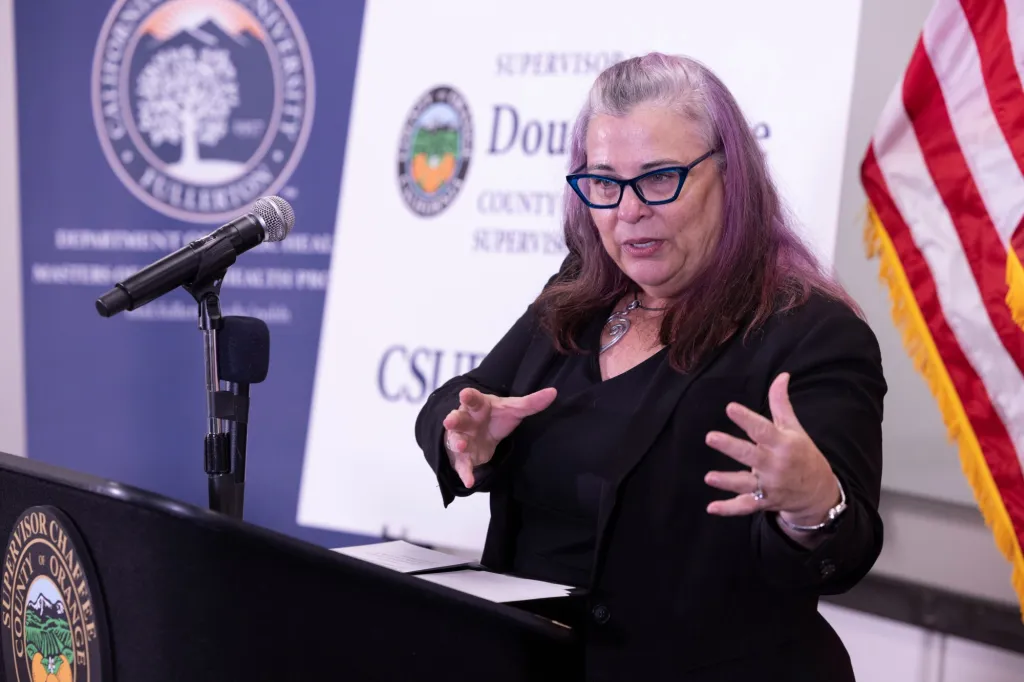
A new partnership between Cal State Fullerton’s Department of Public Health and Doug Chaffee, the Fourth District Supervisor of the Orange County Board of Supervisors, is focused on improving the health of people who live in the city of Stanton.
Chaffee announced in May that he wanted to allocate $450,000 from his district discretionary fund to begin the Community Health Ambassador Program, often referred to as CHAP.
Earlier, Chaffee’s office approached Celestina Barbosa-Leiker, CSUF dean of the College of Health and Human Development, with the idea of partnering to support ongoing community health efforts in Stanton while training students in the Department of Public Health — the next generation of public health leaders — through the Community Health Ambassador Program.
Chaffee has worked with CSUF in the past on multiple projects, including a $5 million workforce development grant with the School of Nursing, among many others, said Michele Wood, professor and chair of the Department of Public Health.
“We are honored that we are considered a trusted partner with faculty, staff and students who are collaborative, culturally competent, and who value opportunities to work with local organizations to improve community health,” she said.
The Orange County Board of Supervisors approved the allocation of Chaffee’s funds, and the program officially launched on Aug. 20.
Graduate students participating in the two-year program have already begun their work. They will be paired with community partner agencies, Wood explained, where “they will analyze available data to assess community needs, develop evidence-based programs and policies and evaluate programs in ways that help the Stanton community.”
A team of faculty with diverse expertise will support students on group projects designed with the input of partner organizations, with the goal that solutions will eventually be adopted and put into practice.
Stanton, a small city with a population of more than 41,000, filling an area of about 3 square miles, was chosen by Chaffee’s team, Wood said. “As a small city, it faces the challenges of small cities, particularly related to having fewer resources to invest in primary prevention—preventing health problems before they occur,” she said.
Primary prevention is a major focus of public health, Wood explained. “Our hope is that CHAP can help support the programs and organizations that are already doing important work to support community health in the area.”
The collaboration is designed to benefit everyone involved.
Students will gain practical experience in a public health effort and learn that working with the community and key stakeholders can have the greatest impact, Wood said.
“I hope they learn about the challenges of doing good work in the real world, as well as the excitement of contributing to make a positive impact with real effects. And, I hope they make connections and have experiences that make them better prepared for the public health workforce because there is a lot of work to do.”
Stanton residents will benefit from practices aimed at preventing illness in their city. “For Stanton, I hope that our efforts will allow us to work together, pooling insights, data and perspectives to identify factors that influence community health in the city,” Wood said. “Preventing health issues before they occur is more effective and cost-efficient than addressing them after they have materialized. I’m hopeful we will find a way to expand primary prevention and sustain aspects of the program moving forward.”
The program’s collaboration between the CSUF and Stanton’s community agencies has won enthusiastic support from President Ronald Rochon. The program will also rely on interdisciplinary collaboration, according to Wood.
“Public Health is a unique academic field in that it spans so many areas of expertise,” Wood said. “Our department faculty includes epidemiologists, interventionists, community health experts, policy experts, economists, statisticians, psychologists, urban planners, biochemists, as well as faculty who focus on topics such as climate and environmental impacts on human health.”
Students are trained to intervene at three levels of prevention — before a health event occurs; early, before damage occurs; and after a health event over the long term, Wood said. “To have the largest impact, we train our students to work at the community level. And most importantly, we prepare them for working on interdisciplinary teams in real communities with real health challenges,” she said.
The Department of Public Health at CSUF offers a bachelor of science degree, an undergraduate minor in public health and a master of public health.